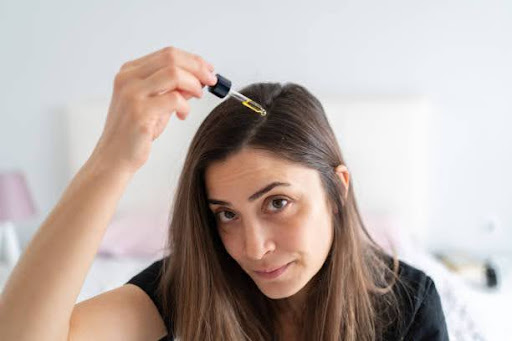Hair serum has become an essential part of many hair care routines, offering various benefits to address a range of hair concerns. Whether you are looking to add shine, control frizz, or protect your hair from damage, understanding what to expect when using hair serum can help you make the most of this versatile product.
In this article, we cover the benefits, and how to use it for the best results.
What is Hair Serum?
Hair serum is a silicone-based styling product that coats the surface of your hair, providing a protective layer that helps to smooth and shine. It is typically lighter than oils and is designed to be applied to damp or dry hair. The formulation of hair serums can vary, but most contain ingredients like silicones, ceramides, and amino acids, which work together to improve the hair’s appearance and manageability.
Benefits of Using Hair Serum
1. Frizz Control:
One of the primary benefits of using hair serum is its ability to control frizz. Humidity and moisture can cause hair to swell and become frizzy. Hair serum works by creating a barrier on the hair shaft that prevents moisture from entering, thus keeping frizz at bay. This makes hair serum particularly beneficial for those with curly or wavy hair, which is more prone to frizz.
2. Shine and Smoothness:
Hair serum adds a glossy shine to your hair, making it look healthier and more vibrant. The silicones in the serum reflect light, giving your hair a sleek, polished appearance. Additionally, hair serum helps to smooth the cuticles, reducing roughness and making your hair feel softer to the touch.
3. Damage Protection:
Environmental factors like pollution, UV rays, and heat styling can cause significant damage to your hair. Hair serum acts as a protective shield, minimizing the impact of these damaging elements. Many serums also contain UV filters that protect your hair from sun damage, as well as ingredients that help to repair and strengthen the hair shaft.
4. Detangling:
For those who struggle with knots and tangles, hair serum can be a game-changer. It lubricates the hair, making it easier to comb through and reducing breakage. This is especially useful for individuals with long or thick hair that tends to tangle easily.
How to Use Hair Serum
Using hair serum effectively involves understanding the right application technique and the appropriate amount to use. Here are some tips to help you get the best results:
1. Start with Clean Hair:
Hair serum works best on clean hair. After washing and conditioning your hair, towel-dry it to remove excess moisture before applying the serum. This ensures that the product can penetrate the hair shaft and provide maximum benefits.
2. Use Sparingly:
A little goes a long way with hair serum. Using too much can make your hair look greasy and weighed down. Start with a small amount (about a pea-sized drop) and gradually add more if needed, especially if you have long or thick hair.
3. Apply to the Ends:
Focus the application on the mid-lengths and ends of your hair, where it is typically the driest and most damaged. Avoid applying serum directly to the roots, as this can lead to an oily scalp.
4. Distribute Evenly:
After applying the serum to your palms, rub your hands together and then run your fingers through your hair to distribute the product evenly. You can use a wide-tooth comb to ensure that the serum is spread uniformly throughout your hair.
5. Style as Desired:
Hair serum can be used before or after styling, depending on your needs. If you are using heat styling tools, apply the serum beforehand to protect your hair from heat damage. For a finishing touch, you can also apply a small amount of serum after styling to add extra shine and smoothness.
Choosing the Right Hair Serum
Not all hair serums are created equal, and choosing the right one for your hair type and needs is crucial. Here are some factors to consider:
1. Hair Type:
Different hair types require different formulations. For example, if you have fine hair, look for a lightweight serum that won’t weigh your hair down. If you have thick or curly hair, a richer serum may be more effective in controlling frizz and adding moisture.
2. Ingredients:
Pay attention to the ingredients in the hair serum. Look for nourishing ingredients like argan oil, jojoba oil, and keratin, which can help to repair and strengthen your hair. Avoid serums with alcohol, as it can be drying and damaging to your hair.
3. Specific Concerns:
Consider any specific concerns you have, such as color-treated hair or a sensitive scalp. There are serums designed to address these issues, providing targeted benefits to meet your needs.
Potential Drawbacks
While hair serum offers numerous benefits, it’s important to be aware of potential drawbacks. Overuse of hair serum can lead to build-up on the hair and scalp, making your hair look greasy and limp. Additionally, some serums contain silicones that can be difficult to wash out completely, leading to product build-up over time. To avoid these issues, use hair serum in moderation and choose a formula that is easy to rinse out.
Conclusion
Incorporating hair serum into your hair care routine can transform the look and feel of your hair. By understanding what to expect and how to use it correctly, you can enjoy smoother, shinier, and more manageable hair. Whether you are dealing with frizz, dryness, or damage, the right hair serum can provide the solution you need for beautiful, healthy hair.
Keep an eye for more latest news & updates on Vents Buzz!
